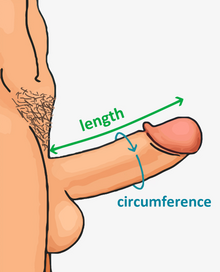
Back Menslike penisgrootte Afrikaans حجم قضيب الإنسان Arabic İnsan penisinin uzunluğu Azerbaijani Sukol kan buto nin tawo BCL মানব শিশ্নের আকার Bengali/Bangla Mida del penis humà Catalan ئەندازەی کێری مرۆڤ CKB Rozměry lidského penisu Czech Арçыннăн ар хатĕрĕн хапи CV Μέγεθος ανθρώπινου πέους Greek

Human penises vary in size on a number of measures, including length and circumference when flaccid and erect. Besides the natural variability of human penises in general, there are factors that lead to minor variations in a particular male, such as the level of arousal, time of day, ambient temperature, anxiety level, physical activity, and frequency of sexual activity. Compared to other primates, including large examples such as the gorilla, the human penis is thickest, both in absolute terms and relative to the rest of the body. Most human penis growth occurs in two stages: the first between infancy and the age of five; and then between about one year after the onset of puberty and, at the latest, approximately 17 years of age.[1]
Measurements vary, with studies that rely on self-measurement reporting a significantly higher average than those with a health professional measuring. As of 2015[update], a systematic review of 15,521 men, who were measured by health professionals rather than themselves, concluded that the average length of an erect human penis is 13.12 cm (5.17 inches) long, while the average circumference of an erect human penis is 11.66 cm (4.59 inches).[2] A 1996 study of flaccid length found a mean of 8.8 cm (3.5 in) when measured by staff.[3] Flaccid penis length can sometimes be a poor predictor of erect length. An adult penis that is abnormally small but otherwise normally formed is referred to in medicine as a micropenis, with the cutoff usually being defined as around 3 inches (7.6 cm).
More recently, the meta-analysis and systematic review by Belladelli et al. (2023) of 55,761 men from 75 studies, done between 1942 and 2021, and based on estimations of pooled mean length, indicated that the erect penis length was 13.93 centimetres (5.48 in), stretched penis length was 12.93 centimetres (5.09 in), and flaccid penis length was 8.70 centimetres (3.43 in).[4] Belladelli (2023) indicated that "all measurements showed variation by geographic region. Erect length increased significantly over time in several regions of the world and across all age groups, while no trends were identified in other penile size measurements. After adjusting for geographic region, subject age, and subject population; erect penile length increased 24% over the past 29 years."[4] Belladelli (2023) also indicated that "importantly, when the current analyses were adjusted for the technique to achieve erection, the point estimates remained similar."[4]

Limited to no statistically significant correlation between penis size and the size of other body parts has been found in research. Some environmental factors in addition to genetics, such as the presence of endocrine disruptors, can affect penis growth.
- ^ Stang, Jamie; Story, Mary (2005). "Ch. 1. Adolescent Growth and Development" (PDF). In Stang J, Story M (ed.). Guidelines for Adolescent Nutrition Services. University of Minnesota. p. 3. Retrieved 26 November 2012.
- ^ Veale, David; Miles, Sarah; Bramley, Sally; Muir, Gordon; Hodsoll, John (June 2015). "Am I normal? A systematic review and construction of nomograms for flaccid and erect penis length and circumference in up to 15 521 men: Nomograms for flaccid/erect penis length and circumference". BJU International. 115 (6): 978–986. doi:10.1111/bju.13010. PMID 25487360.
- ^ Cite error: The named reference
pmid8709382was invoked but never defined (see the help page). - ^ a b c Cite error: The named reference
Belladelliwas invoked but never defined (see the help page).
© MMXXIII Rich X Search. We shall prevail. All rights reserved. Rich X Search